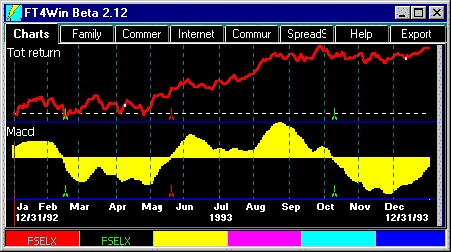MACD Indicator |
||
Moving-Average-Convergence-Divergence (MACD) is a trend-following indicator. When the red line's momentum trend changes, MACD changes.
|
||

|
||
What is MACD (Moving Average Convergence/Divergence)MACD is a momentum indicator. It works when prices bounce like a ball. As the ball rises, it gradually slows until it reaches its peak, and then it accelerates as it falls. MACD follows that motion. The switches occur as the ball becomes motionless at tops and bottoms. The indicator moves above/below the center as the issue reaches tops and bottoms. |
||
How to Interpret MACDMoving Average Convergence/Divergence (MACD) is favorable when the bars are above or approaching the centerline. MACD is unfavorable when the bars are dropping or below the centerline. MACD is computed using the price movement of the fund. The index does not affect the indicator. MACD shows when the momentum of upturn or downturn is accelerating or faltering. |
||
ParametersMACD has three adjustable parameters that are displayed in the upper left-hand corner of the MACD chart. These parameters are (1) the slow (long) moving average; (2) the fast (short) moving average; (3) the trigger average. These parameters are all calculated based on the number of days entered in the Parameters dialog box. Setting the trigger to 1 effectively eliminates a trigger. The signals will be generated by the crossing of the slow and fast moving averages. |
||
trend lines with MACDtrend lines and MACD work well together since they measure different aspects of change: direction and momentum. MACD will give a SELL as a sharp uptrend fades to a modest uptrend, but this is often a premature signal. Also, MACD will whipsaw as an uptrend-follows a steady course. |
|
 What would I use
MACD to DO?
What would I use
MACD to DO?